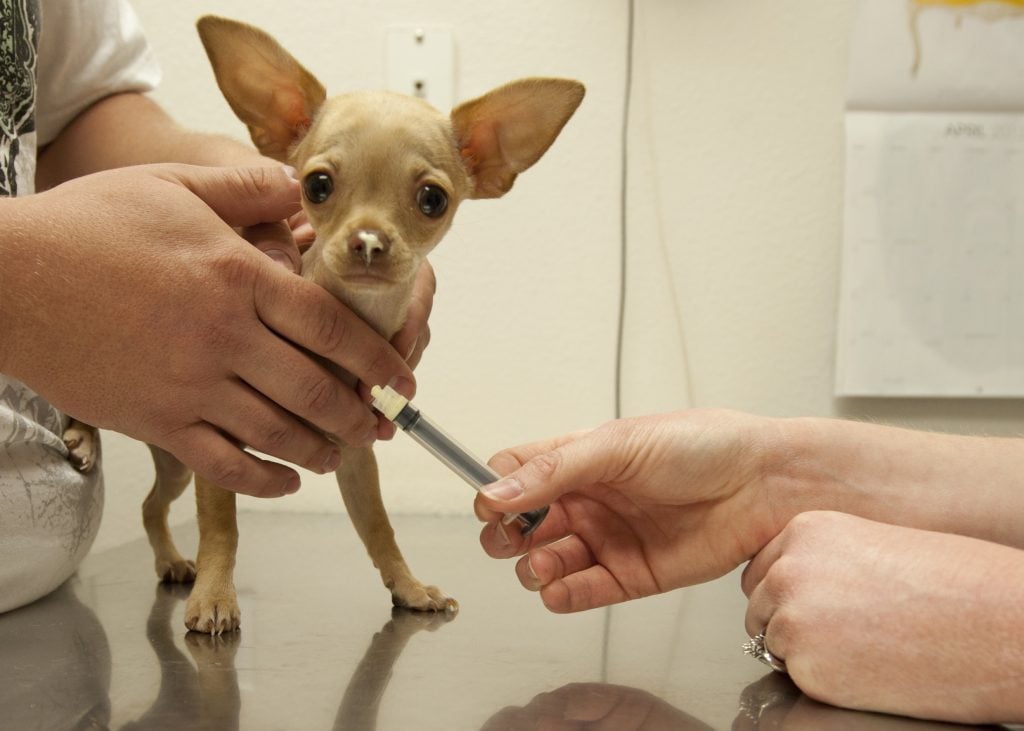Chihuahua itchy skin remedy? What happens when your furry buddy develops skin problems? In addition to making your tiny dog unhappy, itchiness and other skin problems such as scaly, scabby, flaky, oozy, or stinky skin may also be a turn-off for us as pet parents.
Dermatological disorders can affect any dog breed, including the Chihuahua. They may cause our Chis to become lethargic and unhappy because they are uncomfortable in their skin. Skin disorders can cause our Chis to become dull and sad because they are uncomfortable in their skin.
Let’s consider some of the most frequent skin issues that Chihuahuas may have, as well as what your vet may suggest helping your tiny dog get back on his feet.
Causes of Chihuahua Itchy Skin
Dermatitis due to a flea allergy
The fact is that this is a reasonably frequent problem for our canine friends, regardless of their size. Occasionally, some dogs are susceptible to the saliva that enters their skin via flea bites. Results in a skin inflammation that causes redness, scabbing, and severe itching – not pleasant!

This kind of response may trigger by as little as one or two fleas. This is why the most effective preventive and therapy for these puppies is continuous monthly flea control that kills adult bugs before they can sting your dog. Because Chihuahuas are tiny and may be susceptible to certain kinds of over-the-counter parasite treatments. It’s essential to consult with your veterinarian about which form of parasite prevention is appropriate for your dog’s lifestyle.
Mange
Microscopic parasites (mites) that reside in your dog’s skin are responsible for mange development. Two kinds of mites may infect our pups: the Demodex mite. It causes demodectic mange, and the Sarcoptes mite, which causes sarcoptic mange. The Demodex mite is the most usual form of mite seen in dogs or scabies.
Mange may affect a dog’s whole body or only a tiny part of it (localized mange). In certain instances, it can affect just a tiny portion of the body (generalized mange). Even though the signs and symptoms of mange may vary depending on the mite. Mange is often characterize by hair loss, redness, and sometimes severe itching, crusty sores, and thickened skin, among other things.
Your veterinarian will most likely conduct a simple test called skin scraping to identify mange in your Chihuahua. There are a variety of treatment options available for the condition. As part of the therapy, you may request to apply a prescription mange dip or wash on your dog. Although it may also suggest oral medicines or topical drops such as Revolutions.
The majority of dogs need therapy for many weeks, if not months. Antibiotics are often prescribe for poor puppies who have acquire a secondary skin infection due to unfortunate circumstances.
Vacuuming and cleaning your dog’s bedding and toys frequently is essential for keeping mange under control throughout treatment. If Sarcoptes (scabies) are identified, a check-up with your doctor may not a bad idea since you can transfer it to humans via the skin.

Bacterial Dermatitis
An insect bite that has been scratch too often, or a minor scrape that has provide germs with a significant chance, are just a few of the reasons why your Chihuahua may develop a hot spot. Usually caused by anything irritating your pup’s skin, hot spots are red, wet patches are frequently accompanied by seeping discharge or crusts. They occur when germs on your pup’s skin are allow to multiply and infect him, leading to an infection.
As a result of your furry friend’s gnawing or licking of the affected region, other bacteria are introduce into the area, making the illness worse and more likely to spread rapidly within one or two days – a very unpleasant condition. For Your Chi! Cleaning the hot region and applying antibiotics to manage the infection are all possible treatments. May also use corticosteroids and other medications to assist reduce the itching, which can be very uncomfortable.
Allergies
Many Chi owners are all too acquaint with the unpleasant consequences of allergies, and it’s fair to say that the majority of them are Chi owners. A significant percentage of our small canines are allergic to various things such as grass, pollen, dust mites, and mold; allergies to specific dietary proteins are also quite prevalent in our breed.
Chronic issues caused by allergies may be a continuous source of pain for dogs and their owners, resulting in red, itchy skin, discolored fur from chewing or licking, rashes, scabs, ear infections, and hair loss among other symptoms. To make things even more complex, some dogs experience responses to several allergens simultaneously, resulting in a compound impact on our poor pets!

Skin testing, allergy blood tests, and elimination food trials may all use to identify allergies in our pets. Still, there is no ‘cure’ for chronic allergies for most of them – just treatment.
Food modifications, alternative bathing regimens, medication, and limiting exposure to environmental variables, toxins, and foods that we know may give our Chihuahuas sorrow are all possible treatments for various health problems in our canines.
Yeast Infection
Yeast overgrowth in your Chi’s ears, neck folds, and genital region are common, and it may cause a unique scent as well as a greasy sensation to their skin and coat. Overgrowth of yeast is most common in warm, wet places such as their ears, neck folds, and groin area. In most cases, minor quantities of this microbe are found on your pup’s skin. Still, when the skin is already inflame or weaken (as a result of allergies or parasites, for example), yeast may take advantage of the situation and increase, creating its own set of issues.

A vet may swab or scrape your pup’s skin to check for yeast overgrowth because yeast is microscopic. Treatment usually consists of treating any underlying health issues that may have already affected your Chihuahua, as well as medicated shampoos or ear rinses or sprays to help control the spread of yeast in your pup’s ears.
The presence of long-term skin issues in Chihus may be very upsetting for their owners, but there is some other stuff you can do to assist in supporting your little tail-immune wagger’s system and skin health. Regular grooming and ear care for your Chi can help you spot problem areas earlier, which can make treatment easier on your little dog. Feeding high-quality, complete, and balanced food helps your dog maintain a soft, shiny, and healthy coat, as well as an excellent dermal and digestive barrier against allergens and other irritants.
I’ve also discovered that including a small amount of coconut oil in their meals may assist with dry skin. You may even apply it to their dry skin if they have it.
We hope that with the proper mix of attention and care, your Chihuahua will be able to avoid the pain of chronic problems for the rest of their lives!
How to Treat Your Chihuahua’s Itching
When your dog’s skin becomes itchy, it may be very frustrating for him. If left untreated or progresses to a severe level, it may result in hair loss, hot patches, open sores, and skin infections.
Treating your dog’s skin issues as soon as they arise is the most effective method to improve his comfort and minimize the chance of side effects, but it may be tough to figure out how to approach the familiar itch in the first place.
Here are a few of our favorite techniques for healing skin irritations that we’ll share with you in this article.
But always remember that if you have any concerns about your dog’s health, it is best to consult with a veterinarian before attempting a home remedy for the problem.
1. Baths with Oatmeal

The following remedy may familiar to anybody who knows someone who suffers from dry, itchy skin: Itchy skin may relieve by taking an oatmeal bath, which is an old-fashioned treatment for all skin types (canine or human).
Take a handful of baby oatmeal cereal. Alternatively, may substitute regular, plain, unsugared oats. Merge all items in a food processor or blender and blend until they are a fine powder. Add the powder to a hot shower and soak for a while.
The water must be pleasantly warm but not hot; hot water may exacerbate dry skin if not used properly.
Enable your dog to soak in the tub for at least 15 minutes to allow the proteins and oils in the oatmeal powder to penetrate his skin and relieve his skin irritations and itching.
Rinse him well before allowing him to run off to continue playing.
2. Steroids
Veterinarians often prescribe steroids (such as prednisone or dexamethasone) to help manage your dog’s skin issues. These steroids work to reduce inflammation, which in turn reduces skin discomfort and itching.

It is common for dogs to have inflammation directly due to undetected allergies, mainly when issues initially manifest themselves.
Dogs suffering from acute inflammation caused by allergies generally respond well to steroid injections, which may continue for many weeks. This is the fastest and most suitable form of steroid administration. It may be necessary if your pet suffers from persistent autoimmune problems or specific health concerns.
Topical steroids are more effective for some skin disorders. Your veterinarian may advise you to apply them directly to the affected region regularly or just when problems arise. The most significant disadvantage of topicals is that dogs have a strong desire to remove them. Usually with their tongues – resulting in upset stomachs.
Aside from the fact that steroids may produce various adverse effects. They should only be taken after all other alternatives have been tested or when symptoms have grown severe.
When a dog receives regular steroid treatment, it should have regular blood work done to rule out liver disease.
3. Exercising and having fun
A happy dog is a distracted dog (as long as you aren’t attempting to train them to concentrate on anything).

Walking, jogging, and fetching with their owners while spending quality time with them reduces the likelihood that their dogs will get bored and begin to worry about their painful areas.
Exercise is essential for your dog’s health in general, so make sure they’re receiving additional attention while their skin is flaring up.
If you have difficulty squeezing in an extra activity into your schedule, ask a neighbor, friend, or dog walker to assist you.
The fact that your dog is physically active will not make his skin issues disappear; nevertheless, a well-exercised dog will sleep better regardless of the discomfort.
4. Shampoos with medicinal ingredients
Medicated shampoos effectively treat specific canine skin problems, but they are particularly effective in addressing hotspots.
Keeping the hair away from the painful region allows you to better grip the area before washing it.
The soaps used in most medicated shampoos include drying agents or antiseptics to clean the wound while also aiding in the drying process and reducing irritation.
Follow all instructions carefully, and discontinue usage immediately if your dog’s skin problem seems to be becoming worse or if your dog exhibits symptoms of redness, inflammation, or ulceration. See our buying guide for Best Shampoo for Chihuahua!
5. Yogurt that is low in fat
Fat-free yogurt includes probiotics, which are beneficial bacteria that assist in maintaining a healthy balance in your dog’s natural gut flora, resulting in improved digestion and skin disease resistance.
If your dog suffers from fungal skin diseases (particularly yeast infections), this medication may be able to help repair their skin.

Fungal skin infections in dogs are frequent; in fact, several illnesses begin as bacterial infections of the superficial dermis that are subsequently colonized by opportunistic yeasts, which is a typical occurrence.
Ear infections may also be caused by fungi, which can cause your dog to scrape at the skin around his face and ears, causing more open sores to develop.
These, in turn, result in additional bacterial infections, making therapy seem like a never-ending vicious cycle that you can never entirely break free from completely.
Adding a spoonful or two of yogurt to your dog’s daily diet can help keep him in balance.
However, the good news is that almost all dogs like plain yogurt (avoid sweetened versions since sugar feeds yeast!).
If your dog does not like yogurt, it is OK to experiment with probiotic-fortified meals. Alternatively, see your veterinarian about probiotic supplements that are suitable for dogs.
6. Dietary Modifications
A lot of the pet meals available on the market today promise to be nutritious. Only a few are well-balanced enough to provide enough nourishment.

Vitamin shortages cause nutritional dermatitis in dogs. It is a skin disease that closely resembles yeast and bacterial skin infections in dogs, but dietary deficiencies cause it.
It’s not always simple to resolve diet-related issues, but it’s always worth a try. It is possible that just changing your dog’s food will be enough to alleviate their problems.
Choose high-quality meals with meat as the primary component and avoid or restrict the use of grains. Inquire with your veterinarian about the possibility of supplementing with Omega fatty acids for extra assistance.
7. Vitamin E Oil is a powerful antioxidant.
Have you ever snapped open a vitamin E capsule so that you may apply the oil to your chapped lips or cracked heels?
The same at-home treatment is effective for treating your dog’s skin issues since dogs, like humans, need Vitamin E to heal their skin.
Additionally, its moisturizing qualities may relieve dry and irritated skin patches, which may reduce the amount of time your dog chews or licks his skin issues and help them heal more quickly. Neither you nor your dog is possible to grumble about the additional massage you give him.
8. Treatments Medication for Fleas and Ticks

Fleas and ticks aren’t the only creatures to be concerned about while outside.
Almost any mite may induce itching in your dog after being bitten. An allergy to a flea or mite bite can turn minor discomfort into a full-blown skin catastrophe. In the realm of canine care, this disease is often referred to as flea dermatitis. The correct term depends on what is causing your buddy’s itching and irritation.
This one is simple to avoid.
Ensure your dog has regular flea and tick treatments and only use medications that your veterinarian has approved.
Do not use inexpensive spot-on, flea collars, or shampoos from the dollar store since many of these products have been shown to cause additional skin irritations. Sure of these may even induce convulsions, neurological problems, or even death in some cases.
9. Benadryl
Benadryl is an antihistamine, which means that it may be beneficial for dogs experiencing severe itching.
It is particularly beneficial for puppies who are having difficulty sleeping as a result of itching. Because of this, it has the unexpected side effect of calming your dog via sedation. It may be desirable if your poor pup is driving himself insane clawing.
While veterinarians may often suggest that you provide average adult or children’s Benadryl to your dog, do not eyeball the dosage or presume that the same dose is correct for your dog just because he considers it similar to your kid.
Call your veterinarian and ask them to give you the proper measurement so that you don’t over-or underdose on your medication.
10. Antibiotics

Bacterial infections may not always cause skin issues in your dog, but open wounds produced by scratching may get infected very rapidly and become infected very quickly.
Your veterinarian may prescribe a topical antibiotic spray and an oral antibacterial to resolve the contamination.
The availability of antibiotics in injectable form varies depending on the severity of the illness, and it is often difficult to determine.
11. Skin Care Treatment
Many dogs react very effectively to several types of skincare treatments administered at the same time. Most veterinarians suggest a comprehensive treatment strategy to address all canine skin problems to get optimal results.
Some therapies are effective in alleviating immediate pain, while others target the underlying cause. In these types of situations, it may be beneficial to have a pharmacist who specializes in compounded pet medicine mix some of your medicines into forms that are simpler for your dog to swallow or for you to administer to him.
12. Oral Medicine
Alternatively, pharmacists may combine an antibiotic cream with steroids or construct a new and custom-designed dietary supplement from scratch.
Other alternatives include adding flavorings to your dog’s oral medicines to make them more attractive, as well as decreasing some of the stress related to giving prescriptions.
Frequently Asked Questions
Q: Do Chihuahuas scratch themselves a lot?
Allergic reactions in dogs are characterized by itchy skin rather than sneezing. Atopy is the medical term for this kind of skin allergy, which is common in Chihuahuas. The foot, tummy, folds of the skin, and ears are the most frequently afflicted human body regions. Symptoms usually show up between the ages of one and three, and they may worsen with each passing year.
Q: What is causing my Chihuahua’s itchiness?
When dog scratching becomes excessive, it is often the consequence of food allergies or environmental triggers such as mold and pollen, which may be challenging to detect. When dogs come into touch with certain chemicals such as insecticides or detergent, they may develop a skin inflammation known as contact dermatitis. Boredom or worry are familiar feelings.
Q: What is causing my Chihuahua’s feet to itch so much?
If your feet feel itching, this is most likely the source of the problem. There are many allergens. As if one allergy wasn’t terrible enough, a dog may occasionally be allergic to several things simultaneously, making things much worse and changing eating habits.
Q: What should I do if my Chihuahua is scratching himself to death?
May alleviate chihuahua itching in many ways. Should limit doggie treats to high-quality food that is appropriate for dogs. Chocolate, cookies, and other baked products should be avoided at all costs, no matter how tempting they may seem. Fleas and other parasites are treated in this manner. Consult your veterinarian to determine if a parasite infection causes the itching.
Q: What is the cause of my Chihuahua’s excessive dryness?
Skin problems, such as dryness, are often caused by the diet that dogs eat. Some meals include a range of different grains and proteins that may cause an allergic response in certain people. Make the switch to organic dog food for your Chihuahua. It is essential that this new dog food has Omega 3 fatty acids and that it does not include the same grains that are already in your dog’s diet.
Final Words
Dog skin issues are among the most frequent causes of veterinarian appointments, accounting for about 20% of all visits.
The more they are left unprocessed, the more probable they may progress from a basic itching to an open wound. It’s crucial to visit the vet first for an appropriate assessment, sensitivity testing, blood results, or even a skin scrape to identify the cause.
Once you know the causes of your dog’s skin problems, you’ll be able to keep your skincare arsenal stocked with everything you need to nip these issues in the bud throughout the year.
Want to know What Are The Common Diseases That A Chihuahua Can Have? We got you covered!
Please share your thoughts about this post.
Here at ILoveChihuahua, we share our personal experiences as owners of this feisty breed. We talk about recommended methods, dog supplies picks, and advice on common Chihuahua problems. Our goal is to promote responsible dog ownership, so there would be fewer Chihuahuas in shelters.


